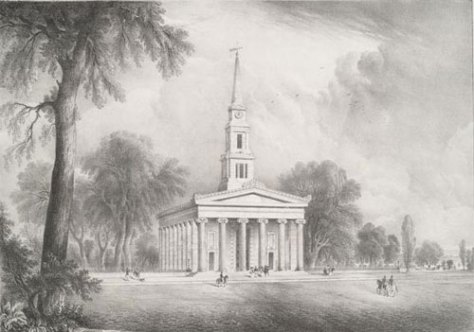St. Mark’s Church stands on the site of the chapel built in 1660 by Peter Stuyvesant, the last governor of Dutch New Amsterdam, and its grounds are all that remain of Stuyvesant’s vast “bouwerie,” or farm. Stuyvesant was interred in the family vault beneath the chapel when he died in 1672. During the 18th century, the chapel fell into a state of dilapidation, until little remained except the foundation and the Stuyvesant family vault beneath. In 1793, Stuyvesant’s great-grandson, Peter Stuyvesant IV, donated the chapel property to the Episcopal Church with the stipulation that a new church be erected. Originally intended to be a chapel of Trinity Parish, St. Mark’s in-the-Bowery was completed in 1799 as the first New York City Episcopal parish separate from Trinity. The Stuyvesant vault is still present under the east wall of the church; it was closed permanently when the last family member was interred there in 1953.


In addition to the Stuyvesant vault, St. Mark’s had two burial sites attached to its church during the first half of the 19th century—the yards surrounding the church, which were used exclusively for vault interments, and a cemetery further east along 11th Street for conventional graves. Peter Stuyvesant IV donated a 242 x 190 plot just east of 2nd Avenue, between 11th and 12th Streets, for the cemetery in 1803. One of the stipulations in Stuyvesant’s grant of the plot was that any of his present or former slaves and their children have the right to be interred in the burial ground free of charge. An unknown number of individuals were buried at St. Mark’s Cemetery until burials there were prohibited in 1851. The remains from this graveyard were removed to Evergreens Cemetery in Brooklyn in 1864 and residences were built on the site.
The first underground burial vaults were built in the grounds adjoining the church in 1807. In these tombs lie the remains of many important individuals and members of prominent and wealthy families of 19th century New York. Among those interred here are Mayor Philip Hone, English governor Henry Sloughter, and Daniel D. Tompkins, governor of New York and U.S. vice-president under James Monroe. Millionaire A.T. Stewart was interred in a vault in the east yard in 1876; two years later his remains were stolen and reportedly held for ransom. The suspicious events surrounding the theft and rumors of ransom demands were well publicized for several years following the crime. The case was never officially resolved, although some stories hold that Stewart’s widow negotiated the return of the remains in 1881 and reinterred them elsewhere.


As the neighborhood surrounding St. Mark’s changed from upper class townhouses to tenement slums during the first half of the 20th century, the churchyard fell into disrepair. The Preservation Youth Project restored it for community use in the 1970s, creating a playground in the east yard and a quiet garden in the west yard. Many of the flat vault markers can still be seen among the newer pavements.


Sources: St. Mark’s Church in-the-Bowery; A Comprehensive Guide to the St. Mark’s Church in-the-Bowery Historical Site (St. Mark’s 1999); Memorial of St. Mark’s Church in the Bowery (St. Mark’s 1899); A New York Pantheon: The Burial List of St. Mark’s in-the-Bouwerie (St. Mark’s n.d.); “Public Notice” [Removal of St. Mark’s Cemetery], New York Times, Aug. 17, 1864; “Ghouls in New-York City,” New York Times, Nov 8, 1878; “New Rector Heard in His First Sermon at Old St. Mark’s,” New York Times Aug 3, 1959; “The Decline and Fall of the Commercial Empire of A.T. Stewart,” Business Review 36(3):255-286, Autumn 1962; “St. Mark’s Building Playground in its Cemetery, the City’s Oldest,” New York Times, Feb. 9, 1970; Dripps’ 1852 Map of the City of New-York extending northward to Fiftieth St.
